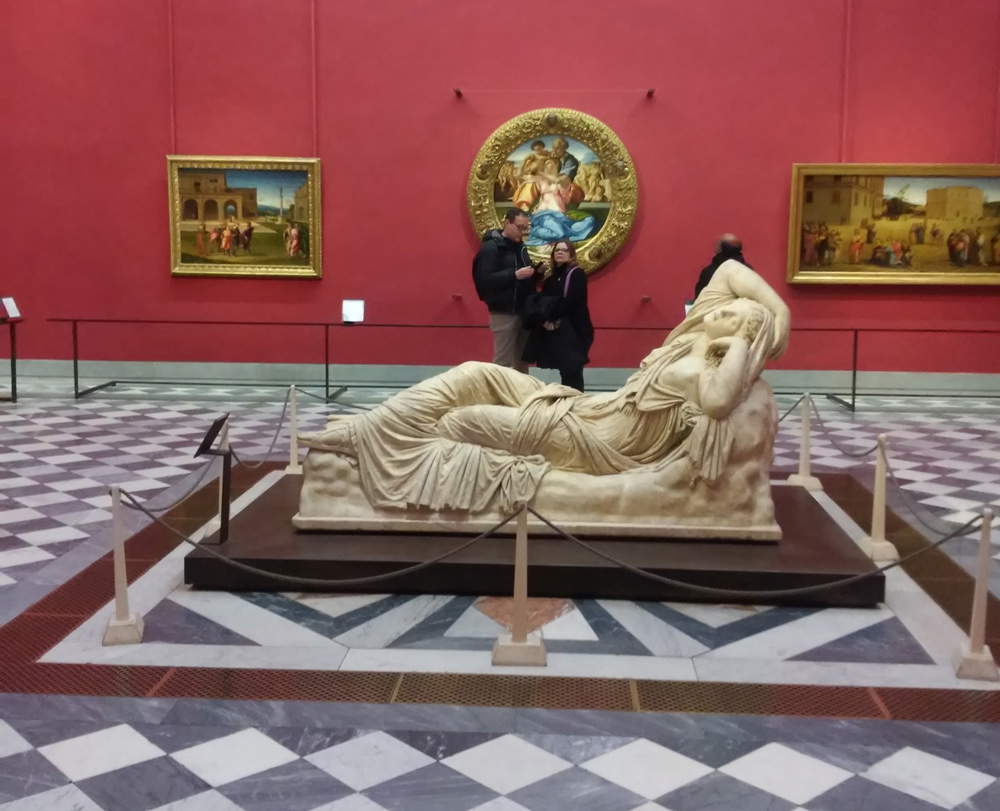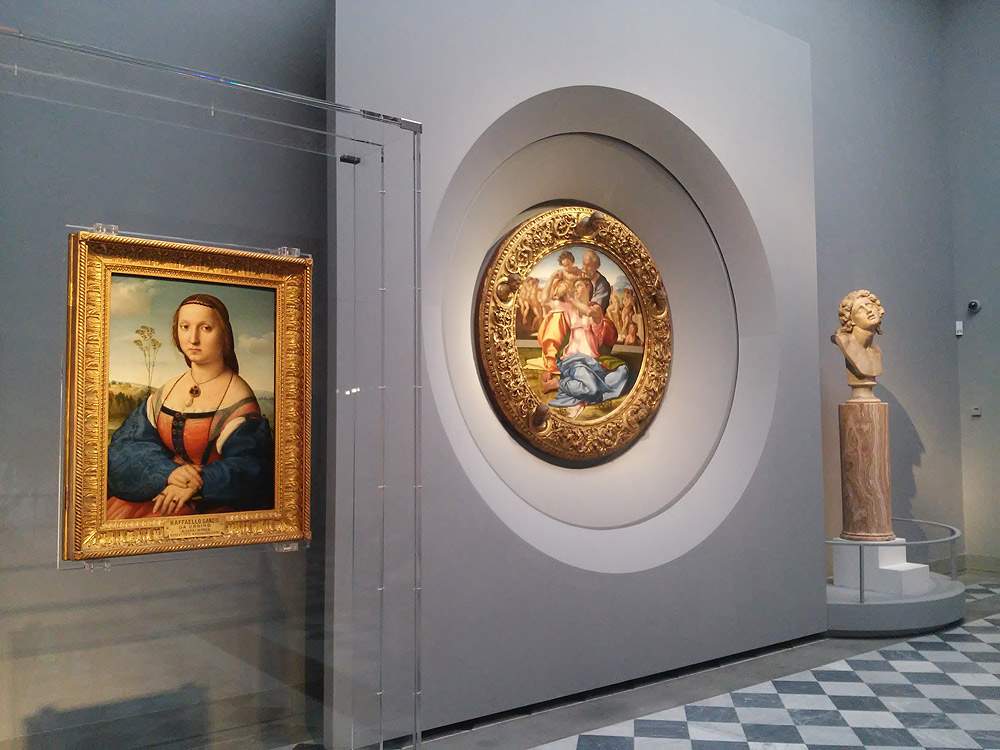Vacca (M5S) against Antonio Natali: "His Michelangelo hall had gaps and errors. The new one restores a logical path."
Last July, LeU MP Stefano Fassina had submitted a parliamentary question (news here) in which he asked Minister Alberto Bonisoli to account for the new arrangement of the Michelangelo room at the Uffizi. In particular, Fassina, who had called the Schmidt-Godoli setup “questionable” in his opinion(all photos here), wanted to know what the minister’s position was on the matter, and how much the operation cost.
The response from the ministry came from Undersecretary Gianluca Vacca (5 Star Movement) who, in an act published a few days ago, explained that “the new arrangements were necessary to restore a logical narrative path that had been distorted over the past decades, in part due to restoration and adaptation works in the various rooms.” Beginning with the premises, “to show Leonardo’s paintings, it was therefore necessary to elect the room in the wing of the Uffizi (3rd Corridor of the Gallery) opposite the one where Botticelli and the Tribuna are located, creating a proper counterbalance to the pressure of the public. Two large rooms - among the largest in the Uffizi - lent themselves well to the purpose, 35 and 41. In keeping with chronology, Leonardo necessarily had to go to the first of the two rooms, No. 35, where Michelangelo had been moved in 2012.”
 |
| The layout of the Michelangelo room in Antonio Natali’s 2012 version. Ph. Credit Finestre Sull’Arte |
The new arrangement of the Michelangelo room was imposed, the act signed by Vacca reads, by “precise and obvious museographic reasons.” In particular, it accuses Antonio Natali’s arrangement, made in 2012, of having several gaps and errors. A first problem, according to Vacca, concerned the position of the Ariadne statue: “in the last editing (Natali 2012), the setting up of Buonarroti’s Tondo Doni and the works flanking it presented various gaps and errors. One of the most serious problems was that the monumental sculpture of the Hellenistic period depicting Ariadne was placed in the center of the room: it is in fact a garden sculpture designed for a niche and therefore for an exclusively frontal view and not a central or circular one. It has in past years constituted a not insignificant impediment for visitors who crowded into the presence of Michelangelo’s famous Tondo, and furthermore (given the crowding) it was very complicated to prevent people from tripping over the sculpture, with consequences for the safety of visitors and the work itself.” Another problem was the red color of the walls of the room, “which was flat and dull, since it was of synthetic composition and industrial production and, as far as an ’objective optical assessment was concerned, exerted a misleading interference on the squillant Mannerist painting. In contrast, the neutral colors - gray, lime white - currently chosen for the rooms, which are of natural origin and applied by trowel with traditional techniques, seen in person do not interfere in any way with those of the paintings.”
Again, Natali is accused of distorting the chronological itinerary by moving Raphael’s works to another room: “in order to privilege the theory of Michelangelo’s influence on the artists of the School of St. Mark, the previous arrangement had made it necessary to move Raphael’s works to another room, which was absolutely incongruous in the chronological sequence of the works: Raphael’s paintings had in fact been placed in a corridor after those of the late sixteenth century, despite the fact that they are all to be dated to the period when the artist was in Florence, at the same time as Leonardo and Michelangelo, that is, between 1504 and 1508. By returning Raphael’s paintings to the room where Michelangelo’s Doni tondo is located, therefore, the correct chronological sequence, inexplicably disrupted by the previous director, Antonio Natali, has been restored.”
And there are also answers for those who had criticized the large vitrines that house the paintings: “the vitrines within which the paintings have been placed have a precise function that takes into account the increase in the number of visitors in recent decades: within these vitrines, in fact, systems with sensors that record humidity and temperature have been placed, and the paintings are protected by shatterproof glass that moreover have the function of minimizing microclimatic variations and cancel out any external interference, at the same time without creating refraction. Thus, the setting has a prevailing task of protection towards masterpieces that are exposed to more than two million visitors each year. As has been rightly pointed out by those in charge of the Opificio delle Pietre Dure in Florence-one of the most important and advanced restoration institutes-these display cases guarantee a level of safety and protection of the works that is absolutely state-of-the-art compared to all other museums in the world.”
The new fittings, according to Vacca, have also improved accessibility: “from the point of view of visitor enjoyment, the wall works of reopening and restoration, by the state, of ancient doors that restore the flow of visitors between Leonardo’s and Michelangelo’s rooms, have today led to improved accessibility, allowing a much smoother visit path and eliminating crossed paths and stumbling blocks.”
In conclusion, Vacca gave a precise account of the costs of the operation. “For these masonry and restoration works and for the technical plant overhaul - in any case prodromal to any kind of setting up - 100,000.00 euros were spent from the Uffizi Galleries’ ticketing. In contrast, the fitting out of the new Michelangelo and Raphael room was carried out exclusively thanks to the liberal donation of the nonprofit associations Amici degli Uffizi and Friends of the Uffizi, which had already paid exclusively for the refitting of the room in 2012. In total, the Friends of the Uffizi and Friends of the Uffizi spent Euro 175,000.00 to create the new Michelangelo and Raphael room. In 2012, on the other hand, the same associations had spent the equivalent of about Euro 100,000.00 to set up the then Michelangelo hall.”
Pictured below: the Michelangelo hall in the Schmidt-Godoli arrangement. Ph. Credit Finestre Sull’Arte
 |
| Vacca (M5S) against Antonio Natali: "His Michelangelo hall had gaps and errors. The new one restores a logical path." |
Warning: the translation into English of the original Italian article was created using automatic tools. We undertake to review all articles, but we do not guarantee the total absence of inaccuracies in the translation due to the program. You can find the original by clicking on the ITA button. If you find any mistake,please contact us.





























